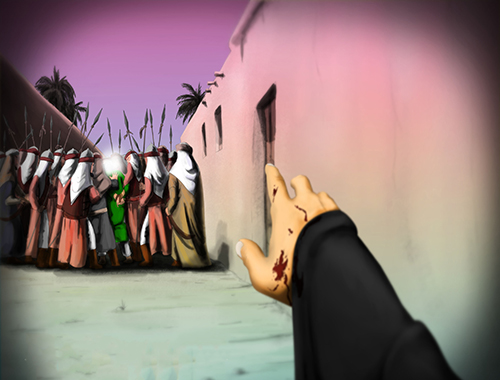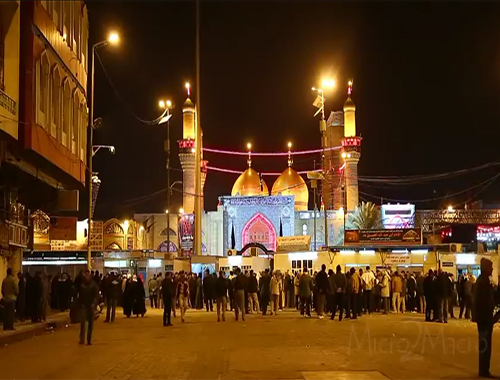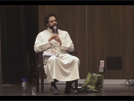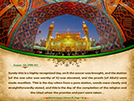Articles
Imam Musa al-Kazim(AS) and the Abbasid Caliphs
- Details
- Hits: 11639
.jpg)
Political Conditions During Imam Kazim's Time
In this eventful period of time revolutions erupted, followed by arrests and mass murders of the descendants of Imam Ali bin Abi-Talib (AS) and their followers. It was a dark age in which men were caught and sentenced to death on the slightest suspicion. The Abbasids monopolized power and thought little of peoples dignity. Eventually, imprisonment, beating and killing became common practices
The rulers began eagerly to buy slaves, jewels, perfumes, clothes, tools of entertainment, pleasure and luxury. They pilfered millions and squandered the wealth of the ummah which they milked from the veins of the oppressed, the hunted, the prisoners or those sentenced to death.
The Abbasids hunted down the descendants of Imam Ali bin Abi-Talib (AS) and their followers, persecuting them in every part of the Islamic state. Men recruited for this purpose were treated lavishly. Their job was uprooting the Alawites, getting rid of their leaders because of their fear of the hostile activities of the Alawites and the love the common people held for them .
Imam Musa bin Ja'far (A.S) followed in the footsteps of his father, Imam Jafar al-Sadiq (A.S). He played a key role in standing against decadence in politics, morals and the Islamic way of life, brought about or helped by the Abbasid rule. Even in prison, he (A.S) didn't give up his responsibility towards the faith and the faithful. Some scholars, and many of his followers and students, kept contact with him secretly, asking him about any aspect of Islamic thought and beliefs. He had his means of writing back to them answering their questions.
Surely the Imam's life represented a distinguished, historical and political period in the history of Islam. During that terrible era (148-183 A.H.) Imam al-Kazim (A.S) took on the responsibility of divine leadership (Imamate) which included the period of the life of Abbasid caliphs Mansoor, Mahdi, Hadi and Rasheed. It was the most prominent deviated period of the Abbasid rule.
The Imam Kazim (A.S) and Abu-Ja'far Mansoor:
Under the rule of Abu-Ja'far Mansoor, Alawites suffered beyond description. They were terrorized in the most heartbreaking way.
Abu-Ja'far Mansoor confiscated the property of the Alawites, threw them behind bars, and hunted them down. He subjected them to unspeakable torture, innovated new ways of killing them, and shed their blood ruthlessly. He put them in half-built pillars and completed the building leaving them there to die. He also withheld food and water from the prisoners to let them die from starvation in the depths of his dark horrible cells. He also used to weigh them down with shackles and chains by which they slowly died.
The Imam Kazim(A.S) and Muhammad Mahdi:
After the death of Abu Ja'far Mansoor, his son, Mahdi sensed the brutality of the policy his father had taken and tried to soothe people's pains at the beginnig of his caliphate. He released prisoners and gave back confiscated property. This decision applied, also, to the descendants of Abu-Talib. The property of Imam Ja'far bin Muhammad al-Sadiq (A.S), taken by the Abbasid authorities, was turned back to his son, Imam Musa bin Ja'far (A.S).
But fear of the strong personality of Imam Musa al-Kazim (A.S) was eating away at Mahdi's heart. He saw how the masses rallied around the descendants of Abu-Talib, and he was worried that there would be an uprising against his rule. As a result, he ordered his governor, in Madinah, to send Imam Kazim (A.S) to Baghdad.
As soon as Imam al-Kazim (A.S) arrived in Baghdad, Mahdi ordered his guard to throw him in prison. But Allah would not forget his devoted servant. He guarded his servant against any evil.
A strange thing happened afterwards which caused Mahdi to withdraw his decision and set the Imam Kazim(A.S) free.
Mahdi, in a dream, saw the Commander of the Faithful Imam Ali(A.S), threatening him and saying: "If you turn away, you are sure to make mischief in the land and cut off the ties of kinship.'" Mahdi awoke, seized with great panic. He sent for Rabi', his vizier, and ordered him to set Imam al-Kazim (A.S) free.
Imam al-Kazim (A.S), released from prison, returned to Madinah,the city of his grandfather, the Apostle of Allah (S.A.W.).
The Imam (A.S) and Musa Hadi:
This ruler (governor) adopted the policy of hatred toward the Alawites, the descendants of Ali bin Abi-Talib(A.S), and the sons of Abu-Talib in general. He persecuted and harassed them. The Alawites, who could endure such savageness no more, revolted against him under the leadership of Hussein bin Ali bin Hassan bin Hassan bin Ali bin Abi-Talib (A.S) near a place called Fakh in 169 A.H.
That was during the Imamate of Imam Musa bin Ja'far (A.S).
That revolt reflected the spirit of the struggle between Ahlul-Bait (A.S) and their followers, and the corrupt Abbasid rulers, because the revolt took place in the time of Imam al-Kazim (A.S), and because of its historical importance, and its significance as a beacon for the Imamate.
This revolution was the most prominent one of Ahlul-Bait and the most tragic one after the revolution of Karbala' which was led by Imam Hussein (A.S).
After puting an end to the revolution, the caliph, Hadi, began threatening Imam al-Kazim (A.S) and decided to capture and imprison him, but it was the Almighty Allah's will that the Abbasid caliph died before carrying out his order on the Imam (A.S) and whom his brother Harun Rasheed succeeded.
The Imam (A.S) and Harun Rasheed:
Imam Musa bin Ja'far (A.S), like the other members of Ahlul-Bait (A.S), their followers and the common people, lived in an atmosphere of oppression, terror, and intimidation. At any moment the could be thrown in jail or made homeless.
Historians mentioned diverse tragic pictures and examples of such prisons, and killings of the Alawites and their followers, particularly Imam Musa al-Kazim (A.S), his students and the bearers of his knowledge.
In 179 A.H. the caliph,Harun, made a pilgrimage and began to visit Madinah and ordered the arrest of Imam al-Kazim (A.S). Thus, the Imam (A.S) was captured and sent to Basrah, whose governor was Isa bin Ja'far bin Mansoor. He (A.S..) stayed in prison for a year and, then, the Imam (A.S) was sent to Baghdad and imprisoned there uner Fadl bin Rabi' and in which he remained for a long time. After that, he was imprisoned under Sindi bin Shahak.
Another example is that Fadl bin Yahya Barmaki, a close assistant to Harun Rasheed, was stripped naked, beaten, insulted and cursed publically on the orders of Harun Rasheed, because he provided some comfort to Imam al-Kazim (A.S) while he was in prison.
Here is another document handed down to us by the historians. This time the massacre from the Abbasid authorities is fully described. It is said that when Yahya bin Khalid Barmaki arrived at Baghdad to lay the plans for the assassination of Imam Musa bin Ja'far (A.S), the people were shocked by his mission and fear took hold of them. "People wer greatly troubled, and they plunged into unbridled rumours."
History, also, protrays for us the confessions of Hamid bin Qahtabah who was ordered by Harun Rasheed to commit a great massacre against the Alawi Prisoners.
Rasheed asked him about his loyalty to him, to which Hamid answered that he was quite ready to carry out whatever task he might assign him. When Rasheed felt Hamid was staunchly loyal to him and that he was capable of doing what he wanted him to do, he ordered his servant to give him a sword and take him to a closed house in whose center there was a well. There were three big rooms in the house.
When Hamid opened the door to the first room, he saw twenty men; young, middle-aged and old, from the descendants of Imam Ali bin Abi-Talib(A.S) and Hadrat Fatima (A.S). They were all in shackles and chains. The servant ordered him to kill them and throw their bodies into the well, which he did. Thus, he did the same in the second and third room untill he killed about sixty men from the descendants of Imam Ali (A.S).
Muhammad bin Abi Umair Azadi, historians say, one of the companions of Imam al-Kazim (A.S..) imprisoned in the prisons of Rasheed for about ten years. He was one of the most trustworty men and well-known for his asceticism, devoutness and worship. He was severely punished.
Kashhi said tht he was flogged 120 times with a piece of wood, in the days of Rasheed. He was, also thrown in jail and not set free until he had paid, from his own wealth, 21.000 Dirhams.
It is, also, narrated that among close companions of Imam al-Kazim (A.S) were: Ali bin Hashim bin Barid, Abdulla bin Alqama, and Mukhawwal bin Ibrahim Sahdi. All of them were imprisoned by Rasheed in his prison called Matbiq. There, they remained 12 years."
These are only a few pictures which have reached us, but history contains thousand of other bitter pictures as well.
How Did the Imam Kazim(A.S) Pass his Time in Prison:
Rasheed also ordered the Imam (A.S) to be given over to Fadl bin Yahya, "who received him, locked him in one of his houses and posted guards around the house. Imam Musa (A.S) busied himself in worship. He stayed up all night perfoming prayers and reciting the Holy Qur'an. During the day he was often fasting. He never averted his face from his worshipping site."
Imam al-Kazim (A.S), turned down all offers to intervene on his behalf with the rulers. He frankly told those who asked him to allow them to send a delegation of prominent people to Rasheed to persuade him to set him free.
When Yahya conveyed the message of Rasheed to Imam Musa bin Ja'far (A.S), he rejected the offer which would have put him in a humiliating position, as if he were a wrongdoer. He said to Yahya, "Tomorrow, when we have knelt down before Allah, Who will judge between us, you will know who is the oppressor who has wronged the other. Wassalam."
Thus, the Imam (A.S) through his patience and trust in Allah, the Almighty, defeated all means of injustice and terror, like prison, pressure, chains, distortion of the truth, and deceiving public opinon. Rasheed was let with only one choice-to assassinate Imam Musa al-Kazim (A.S) and put and end to his blessed life.
The Martyrdom of Holy Imam(A.S):
By the only means possible, Rasheed tried to get rid of Imam Musa bin Ja'far (A.S). That is why Isa bin Ja'far, the governor of Basra, refused to kill him, asking Rasheed to relieve him of this job.Imam(A.S) was then transferrd to another prison. While in the prison of Fadl bin Rabi', Imam Musa (A.S) made an impression on him and Fadl bin Rabi', like Isa, refused to commit the crime.
Looking around himself, Rasheed found no one better than the chief of his police on Baghdad, Sindi bin Shahak, a man known to be rough, stone-hearted and merciless, like other criminals, to murder the Holy Imam.
Yahya bin Khalid talked the matter over with Rasheed and assured him that Fadl was an inexperinced young man. He, himself, offered to go to Baghdad, and Rasheed was most delighted at having an offer from an obedient, faithful man. He gave him the permission to perpetrate the crime. Arriving in Baghdad, Yahya instantly held a meeting with Sindi bin Shahak, during which he explanied to him the plan he had made to dispose of the Holy Imam. The latter accepted it gratefully.
According to the plan, poison was given to Imam Musa al-Kazim (A.S) on a plate of dates. Imam Musa (A.S) partook from that food and felt the poison sneaking through his pure body.
In spite of all that, the criminals' souls were not satiated of their evil and malice. The body of Imam Musa al-Kazim (A.S) was left three days in the prison. Then, it was taken and laid on the bridge of Karkh in Baghdad with the herald calling out for people, "This is Musa bin Ja'far(A.S). He is dead. Come and look at him."
The body of Imam Musa bin Ja'far (A.S) remaind on the bridge, while members of the police, of Sindi bin Shahak and wrench the coffin from them, once they crossed the bridge. The men attacked the police, saved the pure body of the Holy Imam and was ritually washed, sprinkled with camphor and wrapped him in a shroud. Baghdad had never witnessed a day like that one, nor had it suffered a tragedy like that. The procession made its way to the cemetery of Quraish in Kazimiyah, Baghdad where the holy body of the Imam (A.S) was laid to rest.










